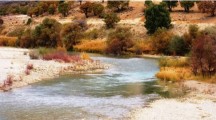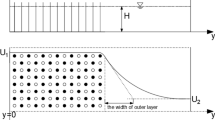Abstract
Riparian vegetation could be an appropriate solution for the flood control and sustainable river management technique as it is useful for the energy dissipation of the stream flows. The present experimental investigation is conducted to understand the flow configuration and energy dissipation of stream flows considering the flexible and rigid vegetation. The laboratory-based physical models are tested in a rectangular flume to observe the flow field in the upstream and downstream of both the vegetations. In this study, rigid vegetation is considered of wooden dowels of equal height and almost uniform diameter whereas for flexible vegetation paddy plants were used. Acoustic Doppler Velocimeter is utilized to observe the velocity profiles at different sections and then it is compared with and without the vegetation. It is noticed that around 24% reduction in stream velocity occurs due to introduction of rigid vegetation whereas 90% reduction happens due to flexible vegetation in the channel. Additionally, energy dissipation at all the sections of both vegetation types was found to give a more comprehensive understanding of the flow field. Overall, the present study provides an insight into the fact that with the help of flexible and rigid vegetation one can restore the ecological balance in the river. The vegetation with high density, height and flexibility will be useful for the dissipation of energy in effective manner. This study also suggests that flexible vegetation will be an effective tool in river management by decreasing scouring in the channel, thereby reducing erosion and sediment discontinuity.







Similar content being viewed by others
Data Availability
The data presented in this study are available on reasonable request from the corresponding author.
References
Box W, Västilä K, Järvelä J (2019) The interplay between flow field, suspended sediment concentration, and net deposition in a channel with flexible bank vegetation. Water 11:24. https://doi.org/10.3390/w11112250
Chen SC, Kuo YM, Li YH (2011) Flow characteristics within different configurations of submerged flexible vegetation. Journal of Hydrology, 398 (2011) 124–134, https://doi.org/10.1016/j.jhydrol.2010.12.018
Cheng NS (2007) Power-law index for velocity profiles in open channel flows. Adv Water Resour 30:1775–1784
Devi TB, Kumar B (2016) Channel Hydrodynamics of Submerged, Flexible Vegetation with Seepage. J Hydraul Eng 142(11):04016053. https://doi.org/10.1061/(ASCE)HY.1943-7900.0001180
Devi TB, Sharma A, Kumar B (2017) Studies on emergent flow over vegetative channel bed with downward seepage. Hydrol Sci J 62(3):408–420
Ferguson R (2007) Flow resistance to gravel-and boulder-bedstreams. Water Resour Res 43(12):W05427. https://doi.org/10.1029/2006WR005422
Finnigan JJ, Shaw RH, Patton EG (2009) Turbulence structure above a vegetation canopy. J Fluid Mech 637:387–424
Ghisalberti M, Nepf HM (2002) Mixing layers and coherent structures in vegetated aquatic flows. J Geophys Res 107(C2):3011. https://doi.org/10.1029/2001JC000871
Ghisalberti M, Nepf HM (2006) The structure of the shear layer over rigid and flexible canopies. Environ Fluid Mech 6:277–301
Huai WX, Zeng YH, Xu ZG, Yang ZH (2009) Three-layer model for vertical velocity distribution in open channel flow with submerged rigid vegetation. Adv Water Resour 32:487–492
Jirka GH (2001) Large scale flow structures and mixing processes in shallow flows. J Hydraul Res 39:567–573. https://doi.org/10.1080/00221686.2001.9628285
Kasiteropoulou D, Liakopoulos A, Michalolias N, Keramari E (2017) Numerical Modelling and Analysis of turbulent flow in an open channel with submerged vegetation. Environ Processes 4(Supply 1):S47–S61. https://doi.org/10.1007/40710-017-0235-x
Klopstra D, Barneveld HJ, Noortwijk JM, van Velzen EH (1997) Analytical model for hydraulic roughness of submerged vegetation. In: The 27th Congress of the International Association of Hydraulic Research, Proceedings of Theme A, Managing Water: Coping with Scarcity and Abundance. ASCE, New York, pp. 775–780
Li RM, Shen HW (1973) Effect of Tall Vegetations on Flow and Sediment. J Hydraulics Div, 793–814
Mavrommatis A, Christodoulou G (2022) Comparative experimental study of Flow through various types of simulated vegetation. Environ Processes 9:33. https://doi.org/10.1007/s40710-022-00576-w
Montakhab A, Yusuf B, Ghazali AH, Mohamed TA (2012) Flow and sediment transport in vegetated waterways: a review,reviews. Environ Sci Biotechnol 11:275–287. https://doi.org/10.1007/s11157-012-9266-y
Montakhab A, Yusuf B, Folkard AM (2015) Flow and turbulence in vegetation in a channel. Proc ICE-Water Manage 168(1):16–23
Neary VS (2003) Numerical solution of fully developed flow with vegetative resistance. J Eng Mech 129:558–563
Nepf HM (2012) Hydrodynamics of vegetated channels. J Hydraul Res 50:262–279. https://doi.org/10.1080/00221686.2012.696559
Nepf HM, Vivoni ER (2000) Flow structure in depth-limited, vegetated flow. Journal of Geophysical Research, VOL. 105, NO. C12, PAGES 28,547 – 28,557, December 15, 2000
Pietri L, Petroff A, Amielh M, Anselmet F (2009) Turbulent flows interacting with varying density canopies. Mécanique and Industries 10:181–185
Rickenmann D, Recking A (2011) Evaluation of flow resistance in gravel-bed streams through a large field dataset. Water Resour Res W07538. https://doi.org/10.1029/2010WR009793
Righetti M, Armanini A (2002) Flow resistance in open channel flows with sparsely distributed bushes. J Hydrol 269:55–64
Rowiński PM, Västilä K, Aberle J, Järvelä J, Kalinowska MB (2018) How vegetation can aid in coping with river management challenges: a brief review. EcohydrologyandHydrobiology,1–10. 345–354. https://doi.org/10.1016/j.ecohyd.2018.07.003
Schnitzler A, Hale BW, Alsum EM (2007) Examining native and exotic species diversity in european riparian forests. Biol Conserv 138:146–156. https://doi.org/10.1016/j.biocon.2007.04.010
White BL, Nepf HM (2007) Shear instability and coherent structures in shallow flow adjacent to a porous layer. J Fluid Mech 593:1–32. https://doi.org/10.1017/S0022112007008415
Wilson CAME (2007) Flow resistance models for flexible submerged vegetation. J Hydrol 342:213–222
Wilson CAME, Stoesser T, Bates PD, Pinzen A, Batemann (2003) Open Channel Flow through Different Forms of Submerged Flexible Vegetation. Journal of Hydraulic Engineering, Vol. 129, No. 11, November 1, 2003, ISSN 0733–9429/2003/11-847-853. https://doi.org/10.1061/(ASCE)0733-9429(2003)129:11(847)
Zhang X, Nepf HM (2009) Thermally driven exchange flow between open water and an aquatic canopy. J Fluid Mech 632:227–243
Acknowledgements
The authors would like to gratefully acknowledge the Ministry of Education (MoE) and the Civil Engineering department, National Institute of Technology, Warangal for providing the required infrastructure for carrying out the experiment.
Funding
NA.
Author information
Authors and Affiliations
Contributions
The first author has analysed the experimental data and prepared the manuscript, the second author has conducted the experimental tests and plotted the graphs and third author has checked the manuscript.
Corresponding author
Ethics declarations
Conflict of interest
The authors have no conflict of interest.
Ethical Approval
Authors declare that they have followed the ethical standards in conducting the present research.
Additional information
Publisher’s Note
Springer Nature remains neutral with regard to jurisdictional claims in published maps and institutional affiliations.
Rights and permissions
Springer Nature or its licensor (e.g. a society or other partner) holds exclusive rights to this article under a publishing agreement with the author(s) or other rightsholder(s); author self-archiving of the accepted manuscript version of this article is solely governed by the terms of such publishing agreement and applicable law.
About this article
Cite this article
Kumar, B., Patra, S. & Pandey, M. Experimental Investigation on Flow Configuration in Flexible and Rigid Vegetated Streams. Water Resour Manage 37, 6005–6019 (2023). https://doi.org/10.1007/s11269-023-03640-8
Received:
Accepted:
Published:
Issue Date:
DOI: https://doi.org/10.1007/s11269-023-03640-8




